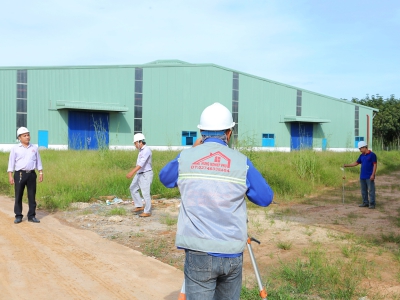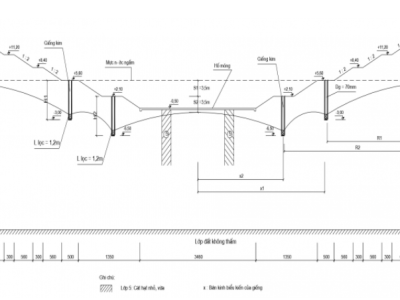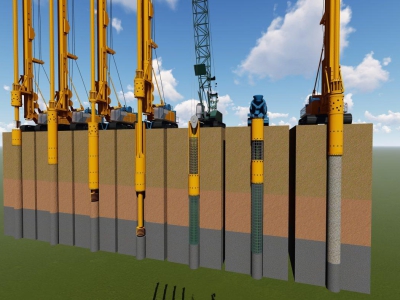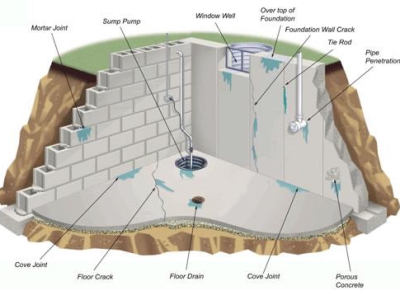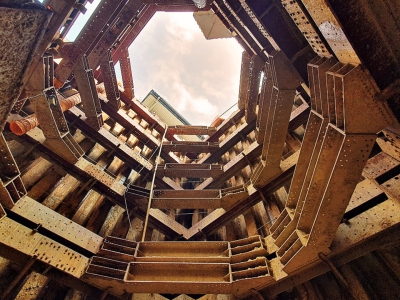CEILING PLASTERING CONSTRUCTION TECHNIQUES
Plastering the ceiling is an important step in the interior finishing process, not only creating a smooth surface but also helping to protect the internal structures and creating aesthetics for the living space. The technique of plastering the ceiling requires meticulousness and high expertise to achieve the best results. Plastering the ceiling must be done first. It is carried out before plastering beams, plastering walls and plastering columns. The ceiling is a structural part located below the roof structure to cover the trusses. The ceiling has an aesthetic and technical function, and prevents dust and dirt from falling from above. In general, after the rough construction, the construction of the house finishing stage is started. Below is the technique of plastering the ceiling, follow Hung Nghiep Phu to follow the article for more details!
1. Classification of plaster layers used in ceiling plastering
Normally, when plastering a house (including plastering walls, plastering ceilings, etc.), there are usually 3 types of plastering: 1-layer plastering, 2-layer plastering, and 3-layer plastering.
- 1-layer plastering: The thickness of the mortar layer is about 1 cm.
- 2-layer plastering: The thickness of the mortar layer is about 1.5 - 2 cm.
- 3-layer plastering: The thickness of the mortar layer is about 2.5 - 3 cm. 3 layers of plastering in civil works are: Primer layer, cushion layer, and outer plastering.
Ceiling plastering uses cement mortar grade 50-75 (Usually grade 75 when plastering ceilings) to convert to the mixing ratio.
Currently, for civil works, when building villas, townhouses, etc., 3 layers of plastering are commonly used. Because 3-layer plastering is easier to create flatness, has a higher gloss. And it is especially effective in revealing less of the inner structural layers. In particular, for projects that do not require plaster ceilings, 3-layer plastering should be used to ensure the requirements of beauty and aesthetics, without being exposed.
The remaining 1 or 2 layers should only be used when plastering unimportant structures, unimportant parts of the structure of the project. Or for ceilings that use plaster ceilings, wooden ceilings or plastic ceilings, 1 or 2 layers of plastering can be used to reduce construction time and finishing costs. And it is also not necessary to plaster 3 layers in this case.
2. Preparation work before plastering the ceiling
Preparations before plastering the ceiling:
Step 1: Prepare tools
- Ceiling plastering tools: Trowel, trowel, ruler, level, wire, etc.
- Ceiling plastering materials: Mix cement mortar according to the correct mix, cement mortar grade 75.
- Erect the scaffolding formwork within the span of the plasterer. Do not erect the scaffolding formwork too close to the ceiling surface as this will cause difficulties and obstacles for the plasterer. The erection position must be appropriate so that the construction worker does not get too tired or too entangled because the nature of the plastering method requires the plasterer to often tilt his head up, which can easily cause neck fatigue.
- Spread bags (often using cement bag shells) or use plastic pads to spread under the surface of the ceiling (under the plasterer's area) to take advantage of the excess mortar that falls down to reuse, avoiding waste.
- Check the ceiling surface before plastering to see if it is suitable for plastering the ceiling or not?
Step 2: Prepare the ceiling surface conditions before plastering
- Clean the ceiling before plastering: The requirement before plastering is to have no dust or dirt. If there is dust, the plaster layers will not adhere to the ceiling surface, so it will not be possible to continue construction. You can use a dry cloth or use a bamboo broom to clean the ceiling surface before plastering.
- Check if the ceiling is rough or concave: Because during the process of assembling the formwork, the construction team can create raised or concave ceiling positions. If it is raised, chisel it out, if it is concave, add more to make the ceiling surface relatively flat.
- The next step in how to plaster a beautiful ceiling is to create a rough surface for the ceiling surface to be plastered: Because the ceiling is too flat and smooth, the plaster will not adhere (not stick) to the ceiling surface. Therefore, it is necessary to create a rough surface for the mortar to stick to.
- Watering the ceiling: The ceiling surface is too dry, which will also cause the plastering to be interrupted and unable to continue, because the dry ceiling makes it difficult for the mortar to adhere to the ceiling surface. Therefore, it is necessary to wet the ceiling before plastering. You can use a sponge soaked in water to absorb water into the ceiling surface.
Preparing the conditions for the ceiling surface as above will make the plastering work more convenient and simpler.
Step 3: Create a benchmark for plastering the ceiling
The ceiling surface after pouring concrete may have sloping places, flat places, so it is necessary to mark and create standard benchmarks so that the ceiling surface becomes flat after plastering.
The work of creating a benchmark for the ceiling in the way of plastering the ceiling is carried out as follows:
- Determine from the beginning how many layers of plaster to use and how thick the ceiling plaster is in centimeters.
- Next, use tools such as: Glue, mortar, nails, broken bricks to make a benchmark; at the corner points then measure the middle points to mark the height. Use a level to balance, mark at different points, or you can use a ruler to locate those marks. Because in the plastering process, there will be a standard mark to follow, so when finished plastering the ceiling will be flat.
3. Ceiling plastering sequence and technique
In general principle: Plaster the ceiling first, then plaster the beams, plaster the walls and plaster the columns
When plastering beams and plastering the ceiling: Proceed to plaster according to the marked landmarks according to the techniques instructed above.
Test plaster a few points first to check the plastering conditions and at the same time check the adhesion of the structural layers.
When plastering the ceiling, divide it into many different plastering layers. Suppose we determine that after completion, the plastering layer will be 2.5cm thick. Normally, a thin plastering layer is not more than 5-8mm thick. Because when plastering layers that are too thick, it will lead to blistering and cracking.
During the plastering process, if you have to stop to wait for the plaster; or in the case that the construction worker wants to take a break, the worker must create stop joints. The requirement of these stop joints is a broken shape; cannot be straight and the plastering layers must be cut perpendicular to each other. Stop joints are interruptions in construction, at this location; The plastering layers before and after stopping are connected and linked together.
Principles of plastering the ceiling: Plaster the ceiling in 3 layers; Primer layer, cushion layer, outermost plaster layer. The primer layer usually uses pure cement; brush on the surface of the ceiling (light foam can be used) to sweep. Then use a layer of cement mortar to plaster the cushion and the outermost layer.
During the plastering process; the worker will check by tapping lightly on the plastered surface; to check the adhesion of the mortar. If there is a lump, they will have to re-plaster. The worker will widen the lumpy area, then tighten the mortar around it; to stagger with the plastered surface to fix it. This inspection must be carried out in parallel with the plastering stage to avoid cracking and crumbling of the ceiling wall later.
How to apply plaster: Use a trowel, a trowel, and a ruler to smooth the plastered ceiling. In the final layer of mortar, people often mix dry cement mortar and sand, without adding water. Then use a trowel and a ruler to flatten the ceiling.
Perform the beautiful plastering of the ceiling according to the above technique; you will complete the beautiful, flat and accurate ceiling as required. You also need to pay attention to a few points below; so that the plastering process is implemented smoothly and easily:
Some notes in the technique of plastering the ceiling include:
- The construction team must strictly comply with the requirements; principles of labor safety when working on scaffolding or at height.
- After plastering the ceiling, it must be protected; covered to ensure that the ceiling surface is not impacted or negatively affected from the outside.
- Maintain the ceiling surface after plastering; Always keep the ceiling surface moist after plastering for 7-10 days; by spraying water on the ceiling.
- During the plastering process, if large particles such as stones, gravel, etc. are found in the plaster, they must be removed immediately so that the ceiling surface after plastering is flat and smooth as required.
- The mortar that falls below should be reused to avoid waste during the process.
4. Introducing a reputable design & construction consulting service provider
The importance of construction units is undeniable, their reputation will ensure the quality and aesthetics of your project. Currently, there are many units providing design and construction services to meet the increasing construction needs in our country. Therefore, finding a reputable unit is not easy and requires you to spend time researching. In the selection process, you need to research carefully and ensure that the accompanying unit must have high expertise, many years of experience, have a clearly signed contract, transparent costs, ... To help customers save time searching, Hung Nghiep Phu Construction Investment Co., Ltd. is confident that it will be the best choice for you.
 Hung Nghiep Phu Construction Investment Co., Ltd. with the mission of providing the best solutions and services, building a prosperous community with customers, Hung Nghiep Phu is gradually affirming its brand through sincere cooperation, with a leadership team with ethical capacity, creativity, high expertise and strategic vision. Hung Nghiep Phu owns a team of skilled, highly qualified employees who will bring customers the best quality technology.
Hung Nghiep Phu Construction Investment Co., Ltd. with the mission of providing the best solutions and services, building a prosperous community with customers, Hung Nghiep Phu is gradually affirming its brand through sincere cooperation, with a leadership team with ethical capacity, creativity, high expertise and strategic vision. Hung Nghiep Phu owns a team of skilled, highly qualified employees who will bring customers the best quality technology.
Hung Nghiep Phu Construction Investment Co., Ltd. - specializes in constructing civil and industrial works. We look forward to accompanying customers in construction projects as well as continuous procedures such as planning diagrams, applying for construction permits, completing procedures, applying for fire prevention and fighting certificates, ... If you have any questions or are in need of design, completing procedures, please contact us immediately for free consultation!
>>> See more:
_____________________
THÔNG TIN LIÊN HỆ:
![]() Facebook: Công ty TNHH Đầu tư Xây dựng Hưng Nghiệp Phú (興業富)
Facebook: Công ty TNHH Đầu tư Xây dựng Hưng Nghiệp Phú (興業富)
![]() Đường dây nóng: 1800.3368 (Miễn phí)
Đường dây nóng: 1800.3368 (Miễn phí)
![]() Trang web: xaydunghungnghiepphu.com
Trang web: xaydunghungnghiepphu.com
![]() Gmail: kinhdoanh01@xaydunghungnghiepphu.com
Gmail: kinhdoanh01@xaydunghungnghiepphu.com
![]() Địa chỉ: Số 2034D, tổ 22, Ấp Phước Thái, P. Thái Hòa, TP. Tân Uyên, Tỉnh Bình Dương
Địa chỉ: Số 2034D, tổ 22, Ấp Phước Thái, P. Thái Hòa, TP. Tân Uyên, Tỉnh Bình Dương
------
Nguồn: Tổng hợp từ Internet








